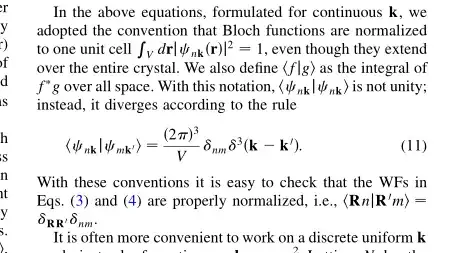In the derivation of Bloch Wave, I encountered a problem. First of all this is the definition of Bloch Wave: $$ \psi_{n\mathbf{k}} (\mathbf{r} ) = e^{i\mathbf{k} \cdot \mathbf{r} } u_{n\mathbf{k}} (\mathbf{r} ) $$ Then we prove its orthogonality: $$ \begin{align} \langle \psi_{m\mathbf{k}'}| \psi_{n\mathbf{k}}\rangle =& \int_{\mathrm{all \\space } } e^{-i\mathbf{k}' \cdot \mathbf{r} } u_{m\mathbf{k}}^* (\mathbf{r} ) e^{i\mathbf{k} \cdot \mathbf{r} } u_{n\mathbf{k}} (\mathbf{r} ) \\ =& \dfrac{(2\pi)^3}{V} \delta(\mathbf{k} - \mathbf{k}') \delta_{nm} \end{align} $$ Where $\delta (i-j) $ is the Dirac function: $$ \int \delta(x) ~ dx = 1 $$ and $\delta_{ij}$ is Kronecker delta: $$ \delta_{ij} = \begin{cases} 1 & i = j \\ 0 &i \ne j \end{cases} $$ May I ask what is the difference between this and the orthogonality of the sdve form, and why there are both the orthogonality of the Dirac delta function and the orthogonality of the Kronecker delta function。
The above question is a simplification of this except that I didn't add the coefficients
This formula is taken from this article Maximally localized Wannier functions
